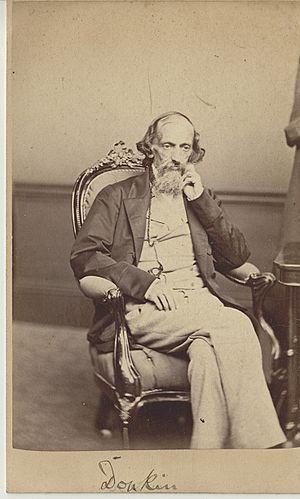William Fishburn Donkin facts for kids
Quick facts for kids
William Fishburn Donkin
|
|
|---|---|

William F. Donkin (US Naval Observatory Library)
|
|
| Born | 16 February 1814 Bishop Burton
|
| Died | 15 November 1869 (aged 55) |
| Nationality | British |
| Education | St Peter's School, York; St Edmund Hall, Oxford |
| Alma mater | University College, Oxford |
| Occupation | Savilian professor of astronomy |
| Known for | The Secular Acceleration of the Moon's Mean Motion |
William Fishburn Donkin (born February 16, 1814 – died November 15, 1869) was a brilliant British scientist. He was an expert in both astronomy (the study of stars and space) and mathematics (the study of numbers and patterns). He became a special professor of astronomy at the University of Oxford. He was also a member of important groups like the Royal Society.
Contents
Who Was William Donkin?
William Donkin was born in a place called Bishop Burton in Yorkshire, England. This was on February 16, 1814. From a young age, he showed he was very smart.
Early Life and Education
William went to St Peter's School, York when he was younger. Later, in 1832, he went to St Edmund Hall, Oxford, which is part of Oxford University. He worked very hard there.
In 1834, William won a special scholarship for his skills in classical studies. Then, in 1836, he achieved something amazing. He got top grades in two different subjects: classics and mathematics. This is called a "double first." A year later, he won more scholarships for his math skills. He officially earned his first university degree in 1836 and a master's degree in 1839. After finishing his studies, he became a fellow at University College, Oxford. He also taught mathematics at St Edmund Hall for about six years.
A Career in Astronomy
In 1842, William Donkin was chosen for a very important job. He became the Savilian Professor of Astronomy at Oxford University. This was a big honor, and he kept this job for the rest of his life. Soon after, he was also made a member of the Royal Society and the Royal Astronomical Society. These are very old and respected groups for scientists.
In 1844, he got married. His wife was the third daughter of a person named Rev. John Hawtrey. Sadly, William's health was not always good. Because of this, he had to live outside of England quite a bit during his later years. He passed away on November 15, 1869.
What He Studied
William Donkin wrote many important papers about his scientific work. These papers were published in special science journals.
Between 1850 and 1860, he wrote articles for a famous journal called Philosophical Transactions. One of his papers was about "Laplace's Functions," which are complex math ideas. Another paper looked at "Differential Equations" that are used to understand how things move.
In 1861, he gave a talk to the Royal Astronomical Society. His talk was about "The Secular Acceleration of the Moon's Mean Motion." This sounds complicated, but it was about how the Moon's speed around Earth changes very slowly over long periods. He also wrote for another journal called the Philosophical Magazine. In 1850, he helped explain the math behind quaternions and spatial rotation, which are ways to describe movements in 3D space. His last paper, in 1864, was about the "Specific Heat of Gases," which is how much energy it takes to heat different gases.
Understanding Sound: Acoustics
In 1867, William Donkin started working on a book about Acoustics. Acoustics is the science of sound. He wanted to explain how sound works, especially how things vibrate to make sound. He studied how strings vibrate, like on a guitar, and how rods vibrate. Sadly, he passed away before he could finish the book. Another scientist, Bartholomew Price, helped publish the first part of his book in 1870, after Donkin's death.

